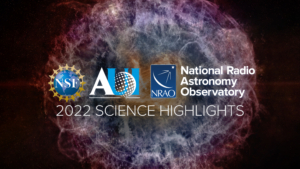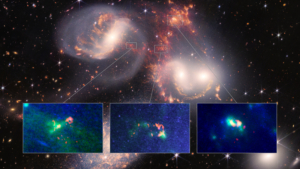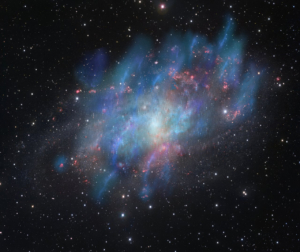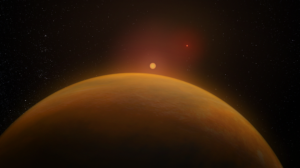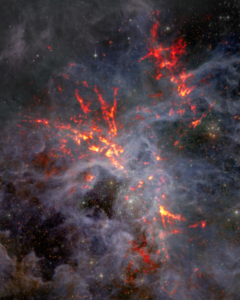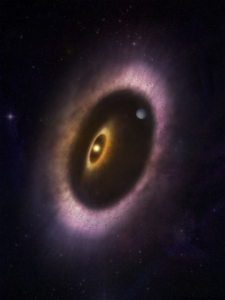The Universe is a dynamic and exciting place, with stars, planets, and galaxies being born, dying, and undergoing dramatic changes. In 2022, the telescopes of the National Science Foundation’s National Radio Astronomy Observatory (NRAO) revealed fascinating new details about several of these processes, and we’re giving you a taste of the greatest radio astronomy moments of the year.
ALMA and JWST Reveal Galactic Shock is Shaping Stephan’s Quintet in Mysterious Ways
Shockwaves resulting from the violent collision between an intruder galaxy and Stephan’s Quintet are helping astronomers to understand how turbulence influences gas in the intergalactic medium. New observations with the Atacama Large Millimeter/submillimeter Array (ALMA) and the James Webb Space Telescope (JWST) have revealed that a sonic boom several times the size of the Milky Way has kickstarted a recycling plant for warm and cold molecular hydrogen gas. What’s more, scientists uncovered the break-up of a giant cloud into a fog of warm gas, the possible collision of two clouds forming a splash of warm gas around them, and the formation of a new galaxy. The observations were presented today in a press conference at the 241st meeting of the American Astronomical Society (AAS) in Seattle, Washington.
VLA Finds Cosmic Rays Driving Galaxy’s Winds
VLA observations revealed that cosmic rays can play an important role in driving winds that rob galaxies of the gas needed to form new stars. This mechanism may be an important factor in galactic evolution, particularly at earlier times in the history of the universe.
VLBA Produces First Full 3-D View of Binary Star-Planet System
Astronomers using the VLBA have produced the first-ever full, 3-D view of binary star system with a planet orbiting one of the stars. Their achievement promises important new insights into the process of planet formation.
ALMA Gets Front-Row Seat to an Ongoing Star-Formation Standoff in the Large Magellanic Cloud
While using the Atacama Large Millimeter/submillimeter Array (ALMA) to observe large star-forming regions in the Large Magellanic Cloud (LMC), scientists discovered a turbulent push-and-pull dynamic in the star-forming region, 30 Doradus. Observations revealed that despite intense stellar feedback, gravity is shaping the molecular cloud, and against scientific odds, is driving the ongoing formation of young, massive stars.
Scientists on the Hunt for Planetary Formation Fossils Reveal Unexpected Eccentricities in Nearby Debris Disk
Using the Atacama Large Millimeter/submillimeter Array (ALMA), astronomers have imaged the debris disk of the nearby star HD 53143 at millimeter wavelengths for the first time, and it looks nothing like they expected. Based on early coronagraphic data, scientists expected ALMA to confirm the debris disk as a face-on ring peppered with clumps of dust. Instead, the observations took a surprise turn, revealing the most complicated and eccentric debris disk observed to date.






